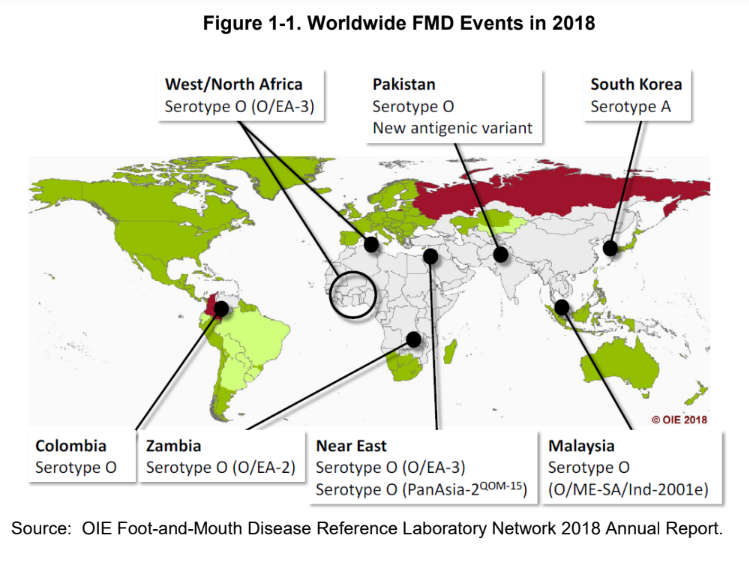



Foot-and-mouth disease SOPs: Overview of etiology
Learn more about foot-and-mouth disease and where it's located in the worldEditor's note: The following content is an excerpt from Foreign Animal Disease Preparedness and Response Plan (FAD PReP): Foot-and-Mouth Disease Standard Operating Procedures: Overview of Etiology and Ecology which is designed to provide operational guidance for responding to an animal health emergency in the US.
Foot-and-mouth disease (FMD) is a highly contagious viral disease that affects domestic cloven-hoofed animals (cattle, swine, sheep, and goats) and more than 70 wildlife species (deer, bison, pronghorn antelope, and feral swine). The disease is characterized by fever, vesicular (blister-like) lesions, and subsequent erosions on the surfaces of the mouth, tongue, nostrils, muzzle, feet, and teats.
FMD is one of the most contagious livestock diseases and endemic in many areas of the world; introduction of FMD into the United States is a serious concern. All secretions, excretions, and tissues are contagious, and the virus may be present in respirations, milk, and semen. The virus enters a new susceptible animal either orally (especially swine) or via the respiratory tract (especially cattle). Aerosol transmission is the major means of animal-to-animal spread within premises. Though FMD virus (FMDV) is not typically considered a zoonotic disease, and is not a threat to public health, there is evidence demonstrating humans can carry the virus mechanically in their nasal passages.
FMD is not normally characterized by high death rates in adult animals, but it can produce morbidity rates of almost 100 percent, resulting in severe losses to productivity. It is probable that all animals in a susceptible population will be affected. Although it does not tend to kill adults, high mortality rates may be observed in young animals.
Goals
As a preparedness goal, the Animal and Plant Health Inspection Service (APHIS) will provide etiology and ecology summaries for FMD, and update these summaries at regular intervals.
As a response goal, the Unified Command and stakeholders will have a common set of etiology and ecology definitions and descriptions, to ensure proper understanding of FMD when establishing or revising goals, objectives, strategies, and procedures.
Etiology
This disease is called foot-and-mouth disease, fiebre aftosa, fievre aphteuse, and maulund-klauenseuche.
Virus characteristics
According to the International Committee on Taxonomy of Viruses, this disease has the following characteristics:
Family: Picornaviridae
Genus: Aphthovirus, containing four species:
- Foot-and-mouth disease virus
Bovine rhinitis A virus
Bovine rhinitis B virus
Equine rhinitis A virus
Baltimore Classification: Group IV (+) ssRNA.
Morphology
FMD is a single-stranded ribonucleic acid (RNA) virus, approximately 30 nanometers in diameter, with icosahedral symmetry. There are 60 copies of four structural proteins, VP1, VP2, VP3, and VP4. These proteins encapsidate a single strand of positive-sense RNA10,11,12
FMD serotypes and strains
There are seven serotypes of FMD: O, A, C, Asia-1, and South African Territories (SAT) 1, SAT 2, and SAT 3. Type O is the most prevalent serotype worldwide, followed by type A. 13 Within these serotypes, more than 60 strains have been identified.14 Figure 1-1 illustrates the typical distribution of serotypes in recent outbreaks. 15,

FMDV is highly susceptible to change, resulting from errors in RNA replication, recombination, and host selection.16 There is no cross-protection between the distinct serotypes.17 Protection within serotypes varies based on the antigenic similarity of the strains. Subsequently, any vaccine must be carefully matched with the field strain to be effective.


